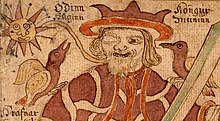Hugin and Munin
Hugin and Munin are the two ravens of Odin in Norse mythology , who is also known as Hrafnáss " raven god ".
etymology
Hugin (Icelandic: Huginn) belongs to the Old Norse verb huga “think”, the associated noun hugi “thought, sense” is the basis for the name Hugin . Munin (Icelandic: Muninn) belongs to the Old Norse verb muna "to remember".
Age and importance
If the depiction of the rider with two birds on Vendel's helmet plate and the depiction of equestrian figures in connection with one or more birds on Scandinavian gold bracteates shows Odin with his ravens, the ravens would already have been used as companion or helper animals of the god for the migration period. In writing, the connection between Odin and ravens is tangible in the Skaldic Kenningar of the 10th century. The names Hugin and Munin only appear in the tradition of the Song Edda and the Snorra Edda .
Snorri Sturluson ascribes a function to them that corresponds to the meaning of their name : “Two ravens sit on his [Odin's] shoulders and say everything in his ear that they see and hear. Their names are Hugin and Munin. At dawn he sends them to fly all over the world and they return at breakfast time. He gets a lot of news from them. "
Comparable is the song Grímnismál :
- Hugin and Munin have to
fly over the earth every day .
I [Odin] fear that Hugin will not return home;
But I care more about Munin.
Modern covers
Hugin and Munin can now be found in the logo of Tromsø University in Northern Norway . Two central streets are named after them on the university campus.
Individual evidence
- ↑ Gerhard Köbler : Old Norse Dictionary, * hā – hǫtuðr , 4th edition, 2014
- ↑ Gerhard Köbler : Old Norse Dictionary, mā – mǫtunautr , 4th edition, 2014
literature
- Heinrich Beck , Bernhard Maier : Huginn and Muninn. In: Reallexikon der Germanischen Altertumskunde (RGA). 2nd Edition. Volume 15, Walter de Gruyter, Berlin / New York 2000, ISBN 3-11-016649-6 , pp. 200-202. ( online )
- Jan de Vries : Old Germanic history of religion. 3 volumes. 3. Edition. Verlag de Gruyter, Berlin 1970.
- Rudolf Simek : Lexicon of Germanic Mythology (= Kröner's pocket edition . Volume 368). 3rd, completely revised edition. Kröner, Stuttgart 2006, ISBN 3-520-36803-X .

